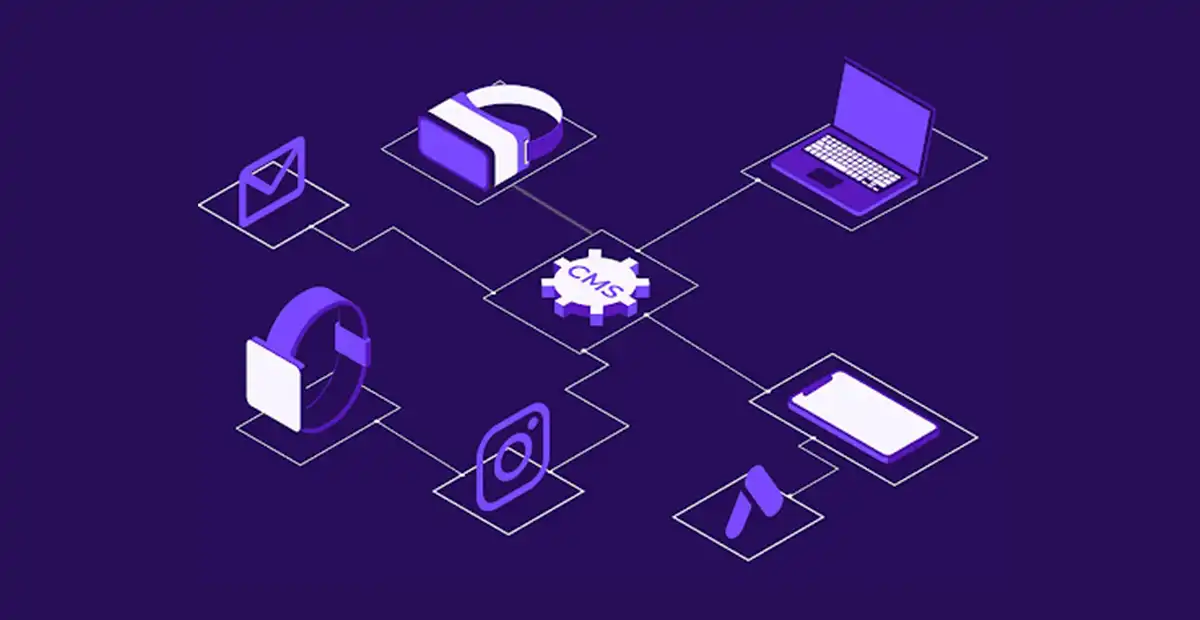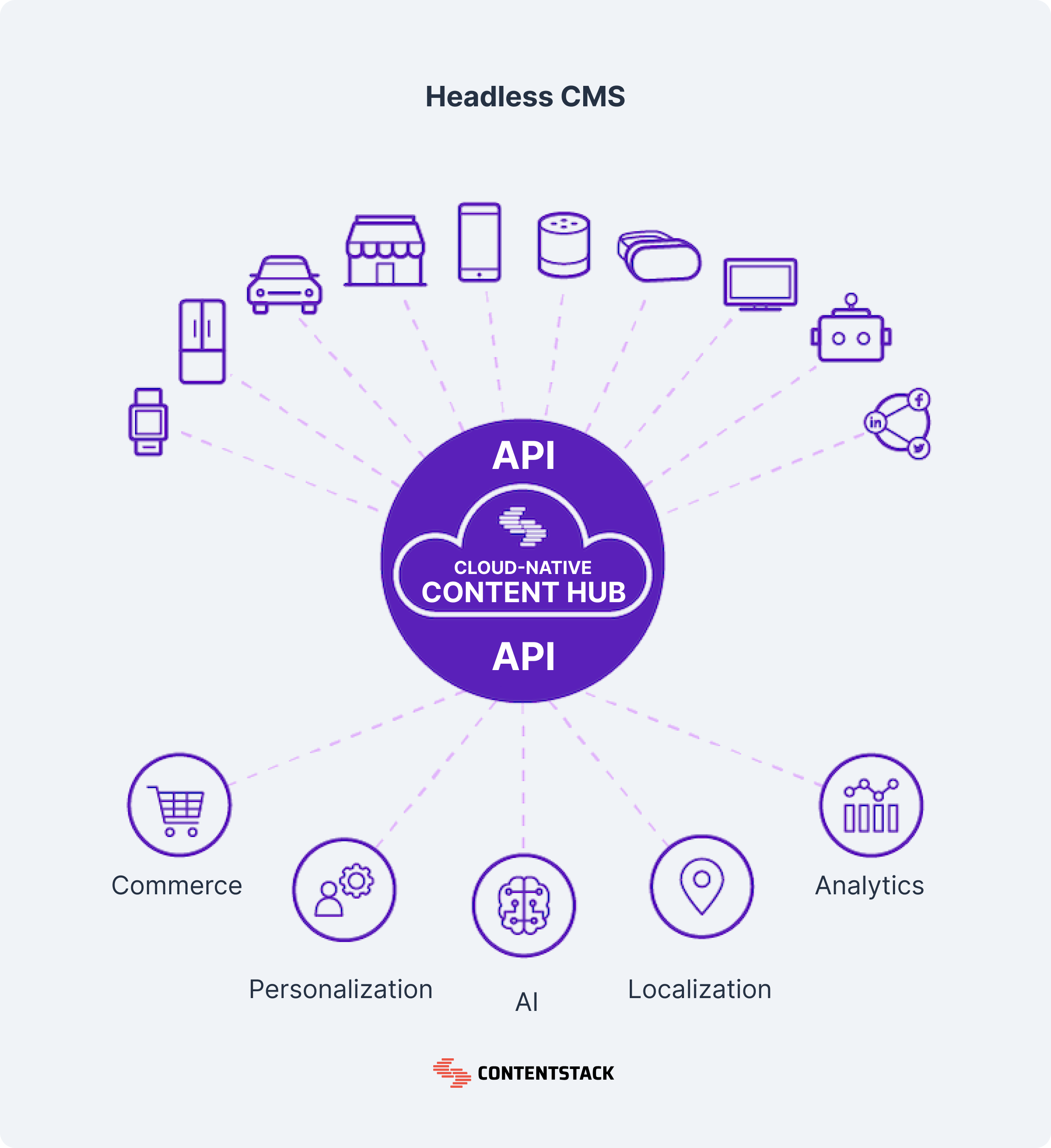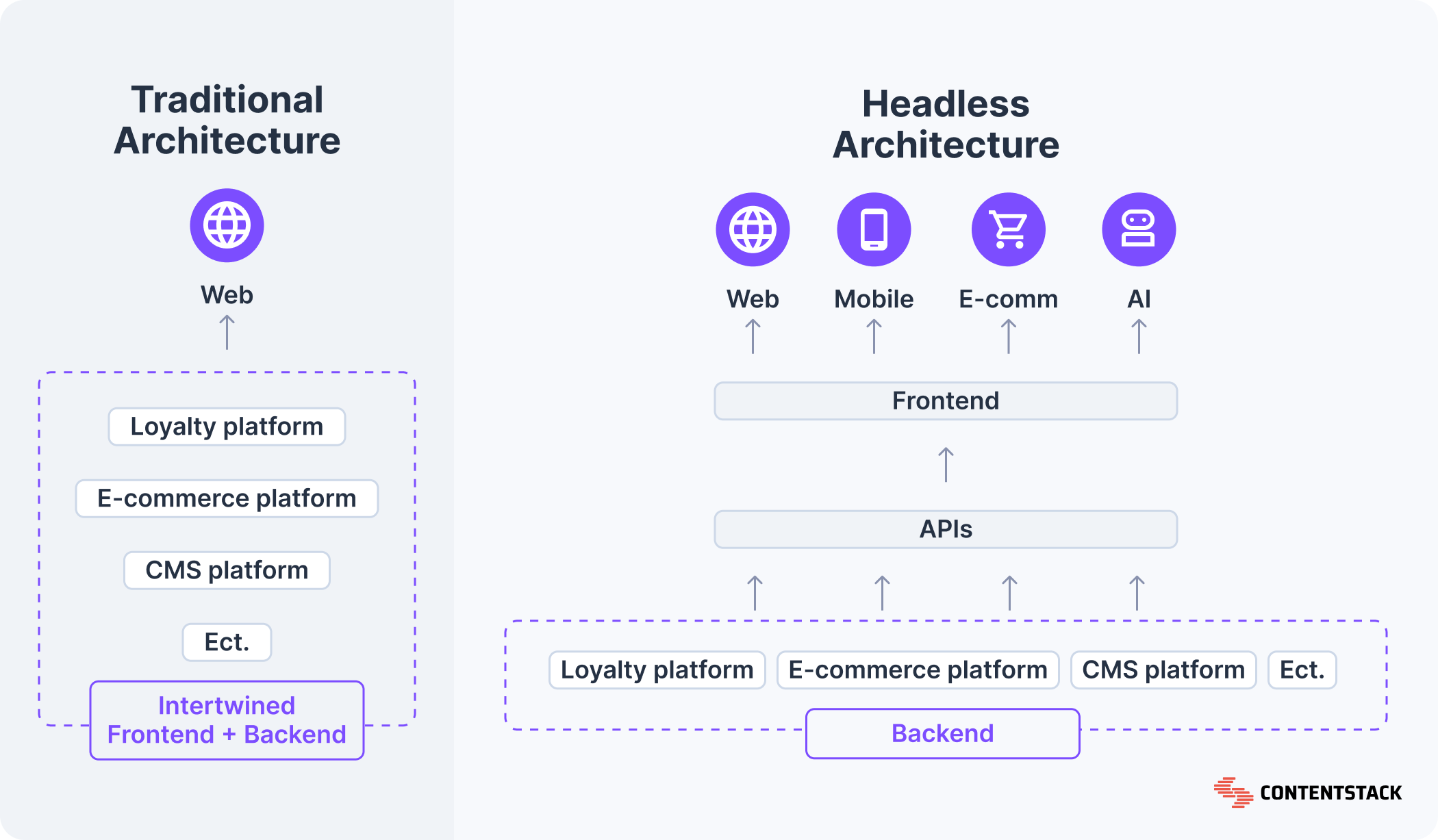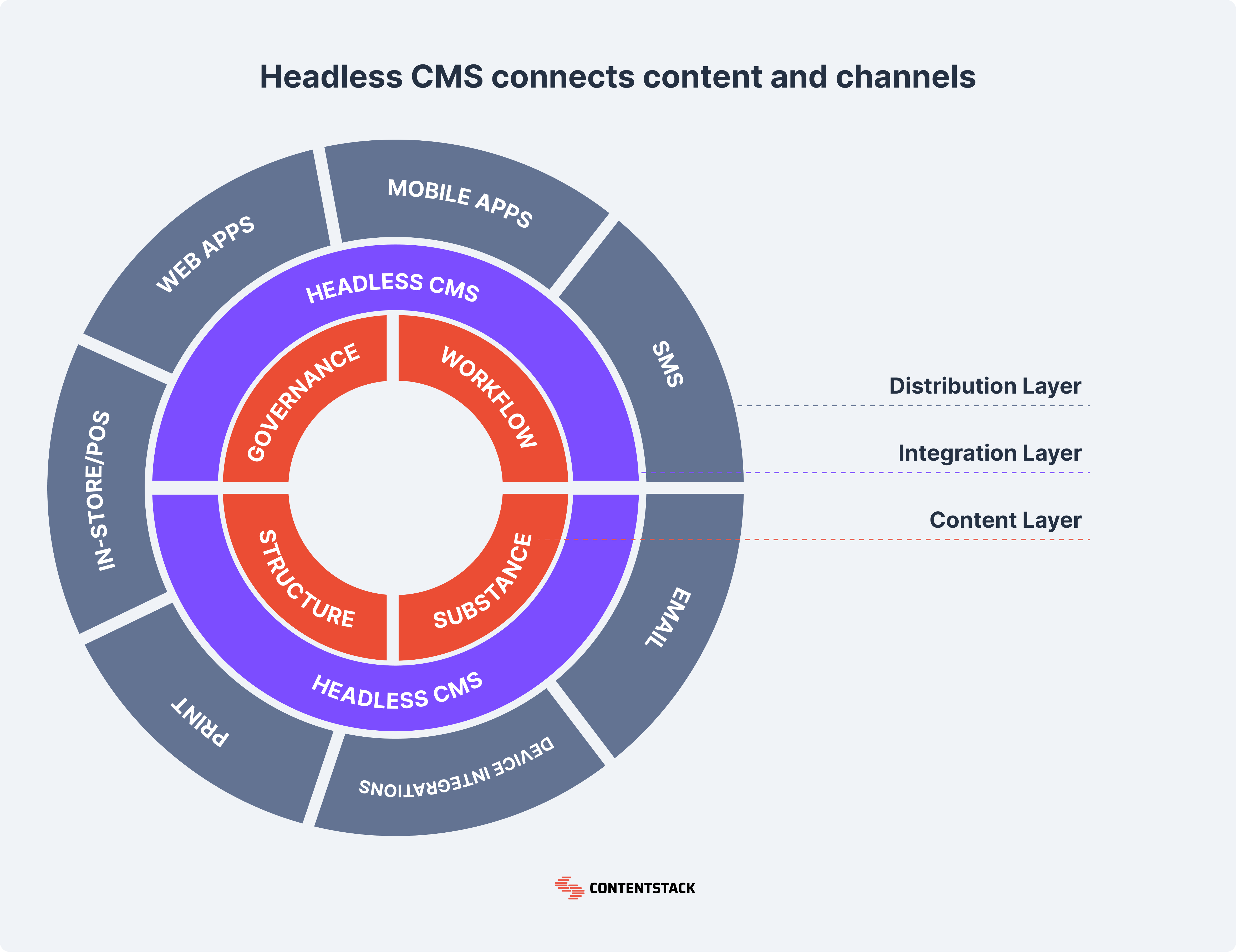Headless CMS: history, benefits, use cases and beyond

Are you ready to switch from a traditional legacy content management system (CMS) to a modern headless one? Use this guide from the pioneers in headless content management to learn the ins and outs of headless content tech, which core elements to shop for, and how to leverage headless to improve your everyday workflows.
Headless CMS overview
A headless CMS is a software platform where marketers create, manage, and organize content assets in a back-end repository. This back end functions separately from the front-end presentation layer, where content creators, designers, and developers create the interfaces that serve content to consumers. Application programming interface (API) technology allows the front end and back end to work together, distributing content anywhere and everywhere you need it — to your smartwatch app, your different company websites in various languages, your customer relationship management (CRM) platform, your 5,000 in-store kiosks across the country and far beyond.

A brief history of headless CMS
In the early years of the internet, the CMS emerged as an essential tool that allowed businesses to manage their websites more efficiently. Some of the first content management tools of note were Vignette’s StoryServer and IBM’s FileNet (which still exists today). These CMSes excelled at creating websites, firmly establishing the web as the world’s first digital channel and CMSes as the vehicles for distributing digital content to growing online audiences.
Then, blogging became popular. And with it, so did some of today’s well-known CMSes, such as Drupal and WordPress. They established WYSIWYG (“What You See Is What You Get”) editing as a leading content management system feature because it allows faster website creation and content publishing. However, traditional CMSes confront an existential challenge in today’s fast-moving digital landscape. They lag when businesses seek the agility to keep up with rapidly evolving technology and customer expectations.
Connected devices have driven an explosion in the number of channels, screens, and formats for content. Any content can be restructured and redeployed in hundreds of contexts across myriad devices today. WYSIWYG editors are just not built to handle this level of complexity. Traditional, legacy CMS solutions only handle 1-to-1 content deployment to a single, static web page. These systems can't move fast enough for the omnichannel world of mobile sites, intelligent billboards, touchscreen displays, Alexa integrations, and smartwatch apps.
All of this presents a challenge for organizations using 20-year-old content management technology. Where once it was advantageous to optimize for a single digital channel, this highly streamlined CMS architecture is insufficient for a world where content must be consistent across many digital channels. From a technical perspective, the old model of intermingling content with the instructions for presenting it (i.e., HTML, CSS, JavaScript, etc.) falls short. Using this model, you can’t limit or control content because you don’t know where your digital content will surface next.
However, the core elements of a headless CMS enable businesses to create content once and publish it anytime, anywhere in a world where competitors move fast and consumer demands even faster. Learn about the rich history of content management systems.
Core elements of an effective headless CMS
There is a core set of features that define today’s most enterprise business-friendly headless CMS platforms.
API connectivity
A good headless CMS runs on APIs. Enabling different applications to work together, APIs create the flexibility and scalability that make all other headless CMS features possible. To learn more about what APIs are, what they do, and how to ensure any headless CMS has what you need, read“Having an API Doesn't Make Your CMS Headless.”
Microservices architecture
Microservices are lightweight applications that can be strung together when connected via API to create very large and functional software systems. Because they are not intertwined, microservices can be swapped out and updated as needed to keep entire systems functional with minimal risk, expense, or downtime. Microservices are the building blocks of many of today’s cutting-edge tools, and modern headless CMSes are no exception. Learn more about them from our article,“Microservices: The Ultimate Guide.”
Content modeling and modules
Content assets are created and stored in content “modules” inside headless CMS platforms. Content modeling is the process of naming and describing the relationships between these modules. A headless CMS with a business user-friendly interface should enable marketers to create, edit, and build out content modules so that content can quickly be re-optimized and republished to various channels. They can work easily without any coding or technical expertise, without the aid of developers.
Simplified integration workflow
Because they’re built on a thoughtful web of API-connected microservices, it’s easy to integrate new tools into headless CMSes. That means developers and designers can use the tools they need to keep the back end and consumer experiences up to date. It also means your tech team can connect the top-of-the-line marketing tools that enable marketing staff to serve the localized, personalized, and optimized campaigns consumers crave.
Easy-to-use interface
Not all headless CMS platforms have a marketing-friendly interface. If you have a large content marketing team that needs to work autonomously and at a quick clip, you should prioritize one that does. Look for an interface with features like real-time content editing previews, workflows that automate the publishing process, roles and permissions that protect content security and accuracy, versioning, rollbacks, etc.
Headless CMS vs. alternative platforms
There’s a lot of lingo to learn in the content management and marketing worlds. Here, we explain some standard terms and platforms you’ll encounter on your headless CMS journey.
Headless CMS vs. traditional CMS
Traditional CMSes are monolithic. The back end and front end are intertwined on a technological level. This means content can only be created and published once to a specific digital instance, such as a static website page. Each content is integrated with the interface where it’s served, so it cannot be re-optimized or republished for different audiences or channels. This was ideal when brand websites were a budding concept. Still, today, it’s a hindrance for marketers who need to reuse content campaigns and designers and developers who need to use modern tools and languages to serve these campaigns.
Traditional CMS is the technology from which headless CMS evolved when omnichannel marketing hit the scene, and content flexibility became a must-have.

Headless CMS vs. hybrid CMS
A hybrid CMS is a headless CMS that still has a front end. For marketers, it can look and function much like a traditional CMS. Still, for developers, it offers multiple APIs with which they can work to serve content on different digital channels. While this provides a solution for business capabilities needing more technical chops to go entirely headless, it has some downsides. Like traditional monolithic CMSes, hybrid CMSes suffer from front-end inflexibility, lack the content modeling and modules that make omnichannel publishing approachable, and feature complex code that can hinder microservice integrations.
Headless CMS vs. DXP
The headless CMS is becoming essential to the digital experience platform (DXP). DXPs serve as central hubs that help organizations bring together all the tools in their tech stacks to deliver meaningful and relevant content to users across multiple channels, boosting customer engagement and improving user experience. Learn more about the digital experience platform concept and why headless CMS is a foundational element to its success in our guide, “What Is a DXP? Understanding digital experience platforms (DXP0.”
Benefits of headless CMS
The headless CMS offers significant benefits for firms growing into new channels, launching new products and integrations, or simply transacting with customers across various digital touchpoints on multiple platforms and devices.
Reduces drain on time and budget
A single headless CMS can store and manage content for unlimited digital channels rather than requiring multiple systems to manage content for your various digital channels. This means you'll spend less money on technology maintenance, and workers will spend less time switching between outdated systems.
Improves morales because it's easy to use
Because of the separation of code and content in a headless CMS, making content updates becomes much easier for content editors who can make changes without any technical or coding expertise. On the other hand, developers can focus on improvements to bring content experiences to life using the latest tools and frameworks.
Maintain content accuracy and security
If your company needs to update content such as an interest rate or a logo, that content must be copied and pasted into multiple systems with a traditional CMS. With headless, the update can be made in one centralized location and then pushed out in the optimized format to numerous systems and channels without duplicating or reformatting it.

Delivers the omnichannel content experiences consumers demand
With headless CMS, content lives in a cloud-first content hub, so deployment is simple and fast. A headless CMS can deliver exceptional content-based experiences across any channel or device, including websites, mobile apps, email marketing, voice-activated digital assistants, AR/VR, and more.
Gets you to market faster with rapid, API-first content deployment
Content delivered via APIs is significantly easier to integrate, manipulate, and distribute, reducing the time it takes to create content-driven experiences. Quickly roll out new sites and functionality incrementally when ready to scale faster.
Limitless integrations power personalization and more
With headless CMS, organizations can streamline processes and deliver seamless customer experiences by connecting content to outside services. When you're powered by headless tech, your content is no longer siloed from systems like CRM, AI/ML, personalization tools, or localization platforms.

Real-life headless CMS use cases
Many enterprise organizations across industries are embracing headless CMS as a foundational element that powers their entire digital experience across all devices and platforms. Headless CMS allows companies to connect with customers at scale, respond quickly to emerging market opportunities, and streamline content operations to enforce consistency while remaining agile.
Some of the top industries and enterprises taking advantage of headless CMS include:
Professional sports teams
Pro sports teams can build omnichannel fan engagement platforms powered by a headless CMS. By marrying content with personalized data, teams can help fans feel more connected than ever to the players they love most.
See it in action: “Miami HEAT Delivers Realtime Personalized Digital Experiences with a Headless CMS”
Airlines
Airlines face some of the most complex content requirements of any industry. Their teams manage real-time communications, global content translation and localization, and an omnichannel presence that spans hundreds — if not thousands — of individual customer touchpoints. A headless CMS enables clear, consistent, and simplified communications that are always up to date across owned web properties, mobile apps, email, third-party search sites, and physical displays.
See it in action: “Icelandair Irons out Integration Issues and Improves Automation and Workflows by Moving to a Headless CMS”
Financial services
Customers in the financial service sector rely on real-time content to inform some of their most important choices. They also demand personalized content that helps them navigate complex processes and make smarter financial decisions. With headless CMS, financial firms have access to the flexibility they need to innovate, the reliable foundation they need to manage content securely, and the integrations they need to provide personalization at scale.
See it in action: “ICE speeds up content delivery, cuts development costs with a headless CMS”
Online retailers
See it in action: “PhotoBox Streamlines Content Publishing with Contentstack’s Powerful APIs”
Beyond verticals
Beyond these verticals, at Contentstack, we've seen many more companies successfully deploy headless CMSs to build modern tech stacks that marry flexibility with speed and innovation with security and reliability.
Future-proof your business with headless CMS
On a steady basis, new channels, new competitors, and new consumer expectations are formed. Ready your teams, workflows, and content for the future with better tools and more knowledge. You can try a modern headless CMS for yourself right now to see if it’s the right tool for your organization. To deepen your understanding, we invite you to check our CMS guides, which cover content management systems and critical concepts like microservices, digital transformation, enterprise marketing, omnichannel content management, and more.
Learn more
Our pioneering headless CMS empowers creative professionals and modern developers to deliver composable digital experiences at uncompromising scale and dependability.
Schedule a free demo to see how Contentstack's headless CMS can help your brand deliver exceptional customer experiences.
About Contentstack
The Contentstack team comprises highly skilled professionals specializing in product marketing, customer acquisition and retention, and digital marketing strategy. With extensive experience holding senior positions in notable technology companies across various sectors, they bring diverse backgrounds and deep industry knowledge to deliver impactful solutions.
Contentstack stands out in the composable DXP and Headless CMS markets with an impressive track record of 87 G2 user awards, 6 analyst recognitions, and 3 industry accolades, showcasing its robust market presence and user satisfaction.
Check out our case studies to see why industry-leading companies trust Contentstack.
Experience the power of Contentstack's award-winning platform by scheduling a demo, starting a free trial, or joining a small group demo today.
Follow Contentstack on Linkedin


.svg?format=pjpg&auto=webp)


.svg?format=pjpg&auto=webp)
.svg?format=pjpg&auto=webp)
.svg?format=pjpg&auto=webp)
.svg?format=pjpg&auto=webp)






